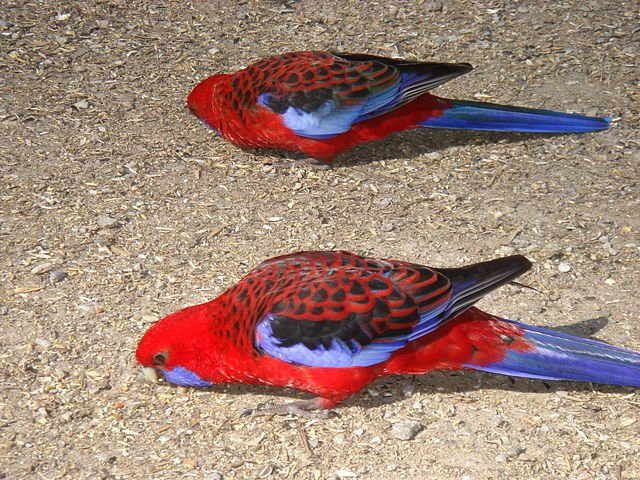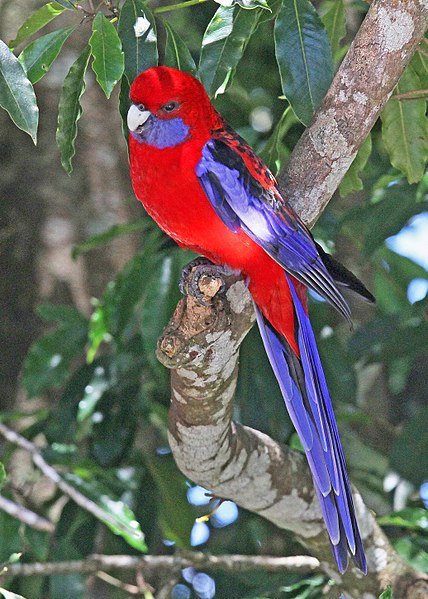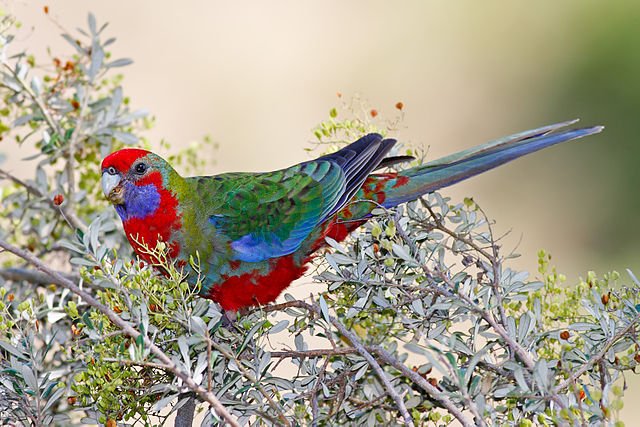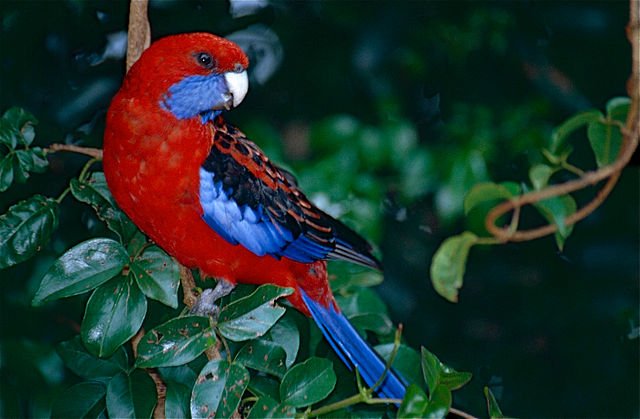Known for their screeching vocalizations, Crimson Rosellas are natives to Australia’s eastern as well as south-eastern regions. Commonly found in gardens and mountain forests, they soon migrated to the surrounding regions of Norfolk Island and New Zealand. And with such beautiful crimson plumage, they became a favored bird companion across the globe in no time. With their introduction to other parts of the world, Crimson Rosellas grew in numbers, courtesy their incessant breeding.
Crimson Rosella Breeding Season
Breeding Months
Crimson Rosellas breed in the wet times of the year. Their breeding season lasts till the rainy months lasts and the longer the wet times of the year, the lengthier their breeding season is. In their native region, the north-dwelling birds breed from early September until late January and the south-dwelling birds breed in the months starting from February to June.
Similarly, in the northern regions of the USA, Crimsons breed between April to September and in the southern regions of the USA, they breed throughout the year.
Crimson Rosella Clutch
Crimson Rosella clutch size ranges between 3 to 8 eggs laid at an interval of about 2 days asynchronously. The eggs are of 28 X 23 mm in size and are white with a sheen.
Incubation and Hatching
The incubation period for Crimson Rosellas ranges from 16 to 28 days. The female Crimson Rosella incubates the eggs solely and the male feeds her and takes care of everything else. The eggs hatch around mid-December with a success rate of around 45%, i.e, around 3 to 4 eggs. Crimson Rosellas produce around 1-2 clutches per season.
For the initial six days, the female feeds the chicks solely and the male Crimson joins on the seventh day, co-parenting the young ones for the next few weeks until February. The chics attain adult plumage at around 16 months old.
Crimson Rosella breeding in the Wild
When in the wild, Crimson males do the task of wooing their mate by making a mating call. He usually bows down on a tree perch near the female Crimson who responds in the same way if interested. Mutual feeding is followed by it before the mating takes place.

The next step is the selection of an apt nesting site and the task is done by the female. Normally, it is a hollow of the tree that is much above the ground level. Most of the Crimson Rosellas nesting sites can be found at around 30 meters above in the trees’ cavities that are roughly one meter deep. More often than not, they are Eucalyptus trees near a water source.
The Crimson pair prepares the nest to make it worth dwelling for the season and raising the young ones. They line it with wood dust and shavings by shredding the surrounding hollow area with their beaks. No outside material like twigs is brought to prepare the nest. Unlike a few other parrot species like Quaker parrots, etc., Crimsons do not share their nests with other Crimson pairs. Also, any approaching flock members are stopped by chattering and bickering. They also make sure that no other Crimson pair nests on the nearby tree. The nest is guarded by either of the partners all the time by staying outside it.
Crimson Rosella breeding in Captivity
Crimson Rosellas are hardy birds and can withstand a good amount of fluctuations in temperature. This makes it easy to breed them. Since they like their nesting sites to be high above the ground and preferably be tree cavities, one can place a hollow tree log high above in the aviary to encourage breeding during the breeding season. Keep a few small-sized logs where they can just fit in. Big-sized logs are avoided by the birds as they lack a snug-fit feeling. To lend a natural feel to the breeding process, hang a few log options at varied heights and let the pair choose their preferred home.
Once they select a nesting site, remove all other alternatives. To maintain uniformity, keep the site exclusive for them for the subsequent breeding seasons too. Make sure to line the nesting site with organic and non-toxic wood shavings. Make sure to keep the site clean so as not to let the pathogens or parasites breed. And if the temperature becomes too harsh, a heat source to keep the nest warm enough for the pair’s comfort is a must.
Crimson Rosella Nest Box
Alternatively, one can also opt to provide a nest box to the pair instead of a hollow log. An ideal nest box for a Crimson pair would be of roughly 10 inches in length and breadth, and 24 inches in height. Place it at the farthest corner of the aviary that has minimal light. If the pair does not select this nest box instantly, then offer him a few boxes of varied sizes that should not be big as they will lack the cozy-fit the pair prefers. They prefer deeper Box in which they feel more secure. The bottom of the nest box should be filled with wood shavings.
Crimson Rosella Breeding Behavior
Crimson Rosellas are monogamous and they prefer to be with their partners, especially during the breeding season. Almost all the time is spent with the mate against the usual flock gatherings. The male Crimson shows aggressive behavior towards the female during breeding months. Most of the aggression is to force the female inside the nest box. And this behavior is more common and extreme if the usual cage size is too small and there is no nest box attached to the cage. So make sure to provide an appropriately big cage to the pair that has enough room for each bird and a small cozy nest box/log that offers enough warmth and privacy to the pair.
More on Crimson Rosella Behaviour:
https://parrotquaker.com/crimson-rosella-behaviour-and-care/
Crimson Rosella Breeding Diet
Crimson’s breeding diet varies with the habitat. They eat differently based on what nature or their breeders have to offer to them.
In the Wild
When in the wild, these birds mostly feed on tree seeds and grass along with many varieties of fruits, nuts, nectar, and flowers from trees like Eucalyptus. Small insects like mealworms are also a part of their diet. During the breeding season, they feed on the larvae to add much-needed extra protein in their diet. For them, insects are an easily-digestible protein form.
In Captivity
When in captivity, Crimsons must be fed a diet that has all the nutrients in the right proportion. Feed them a mix of fresh fruits and vegetables like apples, mangoes, sweet potatoes, kale, cucumber, collard greens, etc. Supplement these with a seed and pellet mix. Seeds like chia, quinoa, barley, etc. are a few great options. Serve these sprouted or soaked to make them chewable for the bird. And for the pellets, there are many high-quality brands available in the pet stores or online that offer balanced nutrition to the birds.
Crimson Rosella Breeding Problems
In the Wild
The biggest breeding problem for a Crimson pair in the wild is a threat to their eggs from predators, which more often than not, happens to be the other Crimson pairs in the vicinity. Like other bird’s eggs, the eggs of Crimsons also get destroyed by predators like foxes, hawks, feral cats, or peregrine falcons. But more than these, for successful hatching of the chicks, it gets important to save the eggs from the Crimson pairs in the neighborhood. The neighboring female Crimsons destroy all the eggs by entering the nest. This is to drive away from the other pair and keep the whole vicinity to self. Disheartened, the pair abandons the nest to find a safer nesting site. This way the dominant pair maintains the monopoly in the area for years.
In Captivity
Since Crimson Rosellas are considered as an aggressive species, it is advisable to keep only one pair of Crimsons in an aviary. Even if two pairs are housed together, make sure to leave a gap between them or install a division between them with mesh wire. The reason being, with another pair in their sight, they lose the focus on breeding and pay much attention to owning the space by being aggressive towards the other pair. They also feel their privacy as a mating pair getting compromised. So, for successful Crimson breeding, housing each pair at an appropriate distance with a little privacy to each is a must.
Useful Tips for Successful Crimson Rosella Breeding
Seeing the challenges in the breeding of this parrot species, one may take extra measures to eliminate all chances of failure:
- Always adopt a young pair, i.e., juvenile Crimson Rosellas, that are unrelated to each other. This helps them bond organically from a young age.
- Make sure the pair aren’t related. Adopt male and female young ones from different aviaries to eliminate the risk factor.
- Provide them a nutritious and balanced diet. Keep the birds hydrated for the smooth functioning of all body processes.
- Maintain the optimum temperature in the aviary to keep the birds comfortable.
- Lastly, offer them a peaceful and stress-free environment. A stressed Crimson pair might end up not mating or abandoning their eggs after laying.
Read about Northern Rosellas :
https://parrotquaker.com/all-about-northern-rosella/





